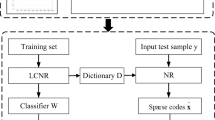Abstract
Physiological signal-based biometrics are gaining increasing attention in the context of increasing privacy and security requirements. This paper proposes a novel electrocardiogram (ECG)-based algorithm to be used for human identification by integrating multiple local feature vectors with sparse-constraint-based sparse coding (SCSC) and bidirectional long short-term memory (BLSTM). Three local feature vectors of ECG signals: morphology characteristics in the time domain, instantaneous characteristics in the frequency domain, and phase spectral characteristics in the phase domain are constructed. Sparsity constraints to model this relationship are imposed because ECGs show high inter-class similarity and subtle intra-class differences in these three domains, and traditional sparse coding (SC) can only learn from a single dictionary. This paper joints optimization of the summed reconstruction error, the sparsity constraints of the correlations and the differences between the feature vectors, proposed the SCSC algorithm. Via this approach, the overlap problem of local feature vectors is solved and a lightweight and interpretable feature vector is obtained. Additionally, the BLSTM-based deep neural network model is supplemented for exploring the spatial information of the reconstructed feature vectors, and a more representative and discriminative signal feature representation is obtained. Comparing five classical machine learning and deep learning algorithms within 360 public samples, using two protocols, we show that, in addition to multiscale information extraction, joint encoding of the correlations and differences between local feature vectors is critically important for feature discrimination. The experimental results demonstrated a high identification accuracy of 99.44%, indicating that the proposed algorithm has practical utility in network information security.





Similar content being viewed by others
References
Biel L, Pettersson O, Philipson L, Wide P (2001) ECG analysis: a new approach in human identification. IEEE Trans Instrum Meas 50:808–812
Cai TT, Wang L (2011) Orthogonal matching pursuit for sparse signal recovery with noise. IEEE Trans Inf Theory 57:4680–4688
Choi G, Bak E, Pan SB (2019) User identification system using 2D resized spectrogram features of ECG. IEEE Access 7:34862–34873
Goshvarpour A, Goshvarpour A (2019) Human identification using a new matching pursuit-based feature set of ECG. Comput Methods Prog Biomed 172:87–94
Hochreiter S, Schmidhuber J (1997) Long short-term memory. Neural Comput 9:1735–1780
Islam MS, Alajlan N (2015) Model-based alignment of heartbeat morphology for enhancing human recognition capability. Comput J 58:2622–2635
Islam MS, Alajlan N (2017) Biometric template extraction from a heartbeat signal captured from fingers. Multimed Tools Appl 76:12709–12733
Islam MS, Ammour N, Alajlan N et al (2017) Selection of heart-biometric templates for fusion. IEEE Access 5:1753–1761
Labati RD, Ballester EM, Piuri V, Sassi SF (2019) Deep-ECG: convolutional neural networks for ECG biometric recognition. Pattern Recogn Lett 126:78–85
Mesin L, Munera A, Pasero E. (2016) A Low Cost ECG Biometry System Based on an Ensemble of Support Vector Machine Classifiers. International Workshop on Neural Networks, WIRN 2015. Smart innovation, Systems and Technologies 54: 425–433
Oh SL, Ng EYK, Tan RS, Acharya UR (2018) Automated diagnosis of arrhythmia using combination of CNN and LSTM techniques with variable length heart beats. Comput Biol Med 102:278–287
Olshausen BA, Field DJ (1996) Natural image statistics and efficient coding. Netw Comput Neural Syst 7:333–339
Peng S, Jiang HY, Wang HX, Alwageed H, Zhou Y, Sebdani MM, Yao YD (2019) Modulation classification based on signal constellation diagrams and deep learning. IEEE Trans Neural Netw Learn Syst 30:718–727
Physionet. PhysioBank [DB/OL]. https://physionet.org/physiobank/. Accessed 21 Nov 2019
Richhariya B, Tanveer M (2018) EEG signal classification using universum support vector machine. Expert Syst Appl 106:169–182
Semwal VB, Mondal K, Nandi GC (2017) Robust and accurate feature selection for humanoid push recovery and classification: deep learning approach. Neural Comput & Applic 28:565–574
Semwal VB, Singha J, Sharma P et al (2017) An optimized feature selection technique based on incremental feature analysis for bio-metric gait data classification. Multimed Tools Appl 76:24457–24475
Shao YH, Zhang CH, Wang XB, Deng NY (2011) Improvements on twin support vector machines. IEEE Trans Neural Netw 22:962–968
Tantawi MM, Revett K, Salem A, Tolba MF (2015) A wavelet feature extraction method for electrocardiogram (ECG)-based biometric recognition. SIViP 9:1271–1280
Tanveer M (2015) Robust and sparse linear programming twin support vector machines. Cogn Comput 7:137–149
Tanveer M, Khan MA, Ho SS (2016) Robust energy-based least squares twin support vector machines. Appl Intell 45:174–186
Yazdi SV, Douzal-Chouakria A (2018) Time warp invariant kSVD: sparse coding and dictionary learning for time series under time warp. Pattern Recogn Lett 112:1–8
Yildirim Ö (2018) A novel wavelet sequence based on deep bidirectional LSTM network model for ECG signal classification. Comput Biol Med 296:189–202
Zhang Z, Zhen L, Deng N, Tan JY (2014) Sparse least square twin support vector machine with adaptive norm. Appl Intell 41:1097–1107
Zhang Q, Zhou D, Zeng X (2017) HeartID: a multiresolution convolutional neural network for ECG-based biometric human identification in smart health applications. IEEE Access 5:11805–11816
Zhao Z, Zhang Y, Deng Y, Zhang X (2018) ECG authentication system design incorporating a convolutional neural network and generalized S-transformation. Comput Biol Med 102:168–179
Zheng M, Bu JJ, Chen C, Wang C, Zhang LJ, Qiu G, Cai D (2011) Graph regularized sparse coding for image representation. IEEE Trans Image Process 20:1327–1336
Acknowledgements
This work was supported by the Industrial Project of Public Welfare Technology research plan of Zhejiang Province (Grant No. LGG20F010008), National Natural Science Foundation of China (Grant No. 61571173), Welfare Project of the Science Technology Department of Zhejiang Province (Grant No. LGG18F010012), Key research and development program of Zhejiang Province (Grant No. 2017C03047).
Author information
Authors and Affiliations
Corresponding author
Additional information
Publisher’s note
Springer Nature remains neutral with regard to jurisdictional claims in published maps and institutional affiliations.
Rights and permissions
About this article
Cite this article
Zhang, Y., Zhao, Z., Deng, Y. et al. Heart biometrics based on ECG signal by sparse coding and bidirectional long short-term memory. Multimed Tools Appl 80, 30417–30438 (2021). https://doi.org/10.1007/s11042-020-09608-9
Received:
Revised:
Accepted:
Published:
Issue Date:
DOI: https://doi.org/10.1007/s11042-020-09608-9




